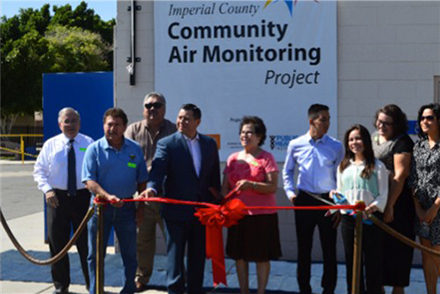By Maggie Wiener

Air pollution is a global public health concern with links to various diseases and medical conditions, including cancer, diabetes, and obesity. Over the past two decades, deaths attributable to air pollution exposure have increased to an estimated 6.5 million deaths a year worldwide.
Microscopic air pollutants called fine particulate matter, or PM2.5, comprise hundreds of chemical components and pose the greatest risk to human health , according to the U.S. Environmental Protection Agency. Because of their small size, these miniscule particles can lodge deeply in the lungs and even enter the bloodstream.
For several decades in China, PM2.5 levels increased dramatically because of intense economic development and urbanization. However, beginning in 2005 the Chinese government instituted a series of air pollution control policies, including a measure to reduce sulfate emissions from industrial operations. Sulfate is a major constituent of PM2.5 and is potentially toxic to health .
Researchers funded by NIEHS developed a model to show how sulfate levels in China have changed over time. The model, they noted, could reveal if China's air pollution policies have led to sulfate reductions and improved public health outcomes.
"We have known particulate matter to be a major health risk factor for a couple of decades, but what components of PM are harmful is still unclear," said lead investigator Yang Liu, Ph.D., professor and chair of the Gangarosa Department of Environment Health in the Rollins School of Public Health at Emory University. "We have already developed a model for particulate nitrate , and in this study, we focused on particulate sulfate, which has sufficient ground observations that we could access to build our model."
Predicting Particulate Sulfate Levels

More on Machine Learning
Machine learning, a method of data analysis used in model building, is based on the idea that systems can learn from data, identify patterns, and make decisions with minimal human intervention. To learn more on machine learning in environmental health research, view this podcast titled The Art of the Algorithm .
Estimates for sulfate pollution in China are available at a large-scale level. For their study, however, Liu's team needed granular data over time in order to investigate if exposure to particulate sulfate is linked with elevated cardiovascular disease incidences. Drawing on years of satellite data on PM2.5 at ground level, the team created a machine-learning model to predict how sulfate concentrations have changed in China from 2005 to 2018. In particular, the researchers focused on the four most populated urban areas in China, including the Beijing-Tianjin-Hebei region in the northern part of the country, the eastern Yangtze-River Delta, the western Cheng-Yu area, and the Pearl River Delta to the south.
Next, the researchers calculated non-accidental deaths and cardiopulmonary deaths attributable to long-term sulfate exposure over time. To inform their analysis, they drew on data from available studies that had investigated links between sulfate exposure and mortality risk.
Using their model, the team found that sulfate concentrations remained stable from 2005 until 2013, when the government enforced an air pollution action plan. From 2013 to 2018, levels significantly dropped by nearly 29%. During that same time, non-accidental deaths and cardiopulmonary deaths also declined by nearly 41% and just over 42%, respectively.
The findings indicate that sulfate emission control policies have been effective in China, according to the authors. In addition, the team's long-term sulfate estimates can inform future studies on PM2.5 exposure in China, as well as global air pollution research.
"This study shows that we have reached a stage where we can look at how air pollution affects human health in more specific and targeted ways, because we are now able to develop better exposure indicators," Liu said. "And this methodology is generalizable beyond China - other than the ground data, everything else in the model is globally available."
NIEHS Leads Air Pollution Research
Liu's work is just one example of NIEHS's commitment to research on the health effects of ambient air pollution. NIEHS has supported several studies looking at various health endpoints or that have focused on populations particularly vulnerable to air pollution exposure, including children, pregnant women, and older people.
For example, the Children's Health Study is one of the largest investigations into the long-term effects of air pollution on children's respiratory health. Among its many findings, the project has shown that days with higher levels of air pollution were associated with short-term respiratory infections in children; kids living near busy roads experienced increased risk for asthma; and children who move to communities with lower levels of air pollution showed improved lung function.
Additionally, researchers are conducting the Bio-Specimen and Fire Effects (B-SAFE) Study , which focuses on how wildfire smoke affects pregnant women and babies. This study utilizes ongoing research that began with the 2017 Northern California wildfires.
Collaborating With Communities

Community collaboration and engagement are also important components of NIEHS air pollution research. For example, NIEHS supports the following community-centered projects:
- The NIEHS-funded Imperial County Community Air Monitoring Project is a large-scale community air monitoring network (CAMN) that has helped community residents monitor air pollution within Imperial County. The project aims to assess whether real-time and modeled air quality levels from a CAMN could assist communities in identifying county "hot spots" - areas with high air pollution levels - with the goal of increasing local capacity to develop and implement effective public health actions. As a result of the project, local residents established a CAMN of 40 particulate matter monitors. The monitoring data are now available online for schools, residents, and agencies to access and use.
- The University of Southern California's Community Outreach and Engagement Program runs the Trade, Health, Environment (THE) Impact Project, partnering with communities affected by trade-related pollution from ports and busy roadways. The program aims to find healthy solutions for impacted communities by combining science, community-based research, and input from people directly affected.


